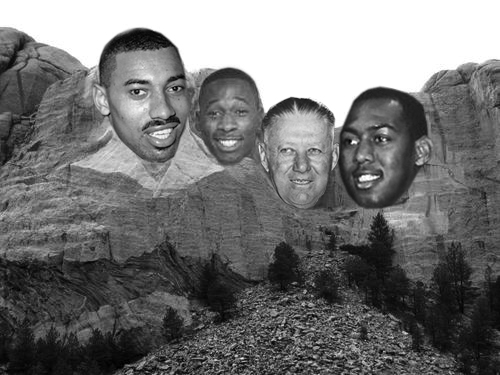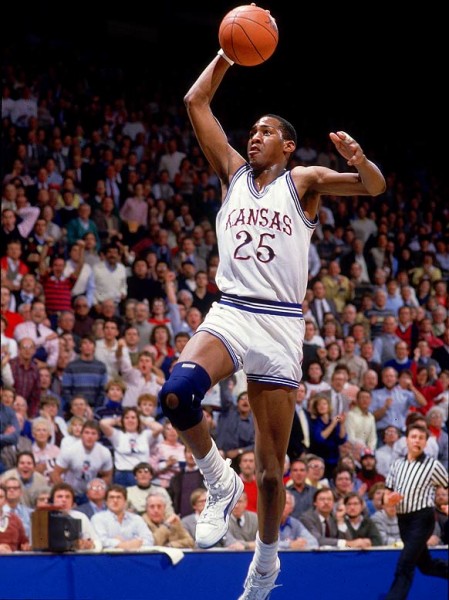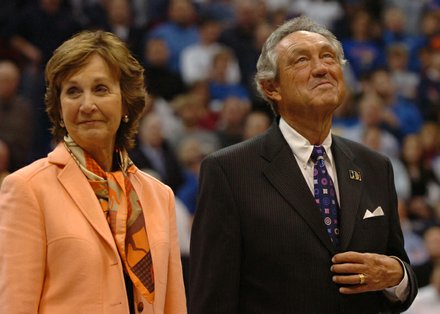Big 12 Mount Rushmore
Posted by dnspewak on February 22nd, 2012When Missouri and Texas A&M bolt for the SEC in July, the departure will mark the Big 12’s first shift since its inception in 1996. For the most part, the past 15 seasons have belonged to Kansas, which has captured the only National Championship during this time period and has also won or shared 11 regular-season championships. The Jayhawks’ dominance extends all the way through the old Big Eight’s history, too. Naturally, we’ve selected two Jayhawks as the most influential figures. Perhaps it’s unfair to place so much KU emphasis on our four Mount Rushmore selections, and yes, it’s probably unfair to ignore the rest of the league as a result. However, we made our selections with an eye toward postseason success and long-term legacy. Frankly, no other Big 12 program can even come close to Kansas in either of those departments, so its players and coaches simply must be included.
Here’s our Big 12 Mount Rushmore:
Wayman Tisdale: The late Tisdale was more than just a basketball player. He was a musician, a man who publicly fought cancer for two years, and most importantly, a man remembered for being one of the most genuine people in sports. The forward had a productive NBA career, but he thoroughly dominated the Big Eight for three seasons at Oklahoma. As a freshman, sophomore and junior, Tisdale took home Big Eight Player of the Year honors, and he was unique in that he made such an immediate impact early in his career. Unlike most freshmen at that time, Tisdale didn’t need time to acclimate himself to the college game. He was a one-and-done kind of player who stayed and dominated the nation for three seasons. Frightening.
Danny Manning: These days, Manning roams the Kansas sidelines as a towering, hard-to-miss assistant coach. Two decades ago, though, Manning’s Jayhawks soared through the 1988 NCAA Tournament as a six-seed, shocking the nation by knocking off #1 Oklahoma in the title game in Kansas City. To this day, even fans who never watched Larry Brown’s team play still refer to that squad as “Danny and the Miracles.” Manning may have scored the most points in Big Eight history, but we’ll remember him for the way he lit up the scoreboard in those six games in March.
Wilt Chamberlain: He’s an idol because of his illustrious NBA career, but Chamberlain’s story began in Lawrence, Kansas, in 1955. After failing to win an NCAA Championship, Chamberlain left Kansas after just two varsity seasons, a common move by today’s standards but unheard of in the mid-1950s. He’s hardly the most successful player to ever play at KU, but you know the story of Wilt Chamberlain by now. During his 14-year NBA career, he changed the rules of basketball and forever altered the way we play this game. The fact that he played his collegiate ball at Kansas is not a minor detail. In fact, it’s a testament to the Jayhawks’ place in this game’s history.
Henry Iba: Although these sorts of historical figures from the pre-modern era are difficult to judge, Iba’s resume speaks for itself. A two-time national champion at Oklahoma State (then called Oklahoma A&M) in the ’40s, Iba’s contributions to basketball extend beyond his tangible success. Iba’s philosophy on both ends of the floor forever changed the way coaches operated. According to The New York Times, Bob Knight even claims “of all the shadows cast over the game of basketball, [Iba’s] was the biggest.” Iba finished with 751 career wins and made the Hall of Fame, of course. He’s also well-known as the namesake of historic Gallagher-Iba Arena in Stillwater.
Honorable Mentions
Bill Self: The only coach in the modern Big 12 to ever cut down the nets, Self has milked Kansas’ spectacular history, fan support and resources since taking over for Roy Williams in 2003. In eight seasons, his program has never finished worse than second in the Big 12, and the Jayhawks have reached the Elite Eight four times during Self’s tenure. Embarrassing NCAA Tournament losses to Bucknell (2005), Bradley (2006), Northern Iowa (2010) and VCU (2011) have defined his legacy to an extent, but those are mere blips on his Kansas resume. Every season, Self recruits at an elite level and meshes his talent into a cohesive, efficient machine on both ends of the floor. Still relatively young at 49 years old, Self is already the dean of this league. And he’ll own the Big 12 as long as he’s there.
Blake Griffin: Griffin emerged as the nation’s top player as a sophomore, earning Player of the Year honors as he physically dominated just about every forward in the Big 12. He became a must-see show for his rebounding, dunking ability and freakish athleticism, even though he played the game with little outward emotion and hardly ever cracked a smile. He didn’t need to. His 2008-09 season will always stand as one of the best individual seasons in Big 12 history.
Eddie Sutton: His tenure at Oklahoma State ended in a disaster: an NIT appearance in 2005-06 and a resignation the following summer due to a bout with alcoholism. However, his rocky ending should not overshadow the consistent winner he built in Stillwater for more than a decade. After the Chris Mills/Eric Manuel scandal ended his time at Kentucky, Sutton experienced immediate success with the Cowboys. Sutton then made a Final Four in 2004 and found a way to lead his team to an NCAA Tournament in 2001 amidst a horrific plane crash tragedy. For all his deficiencies, Sutton’s teams defended and played old-fashioned, nasty (in a good way) basketball. Eddie Sutton was a throwback; the kind of coach typical of the Big Eight era.
Jo Jo White: This perennial All-Star in the NBA earned two All-America selections at Kansas, which helped him springboard that terrific NBA career. White, the 1976 NBA Finals MVP, may unfortunately be best remembered in college for his role on the Jayhawks’ 1965-66 team which lost to Texas Western (yes, that Texas Western) in the Elite Eight. Kansas lost by a point in double-overtime after refs waved off White’s potential game-winner because he stepped out of bounds.
Billy Tubbs: This walking sound-bite would have flourished in this era of 24/7 sports media coverage. His teams played a fast, fun style, and Tubbs put Oklahoma basketball on the map. With 640 career wins to his name, the only thing missing from Tubbs’ resume is a title. Unfortunately, Larry Brown, Danny Manning and the Kansas Jayhawks stole that from him in 1988.
Norm Stewart: Often criticized for failing to reach a Final Four, Stormin’ Norm still won eight Big Eight championships and symbolized Missouri basketball for more than 30 seasons. He may have experienced his share of early exits in the NCAA Tournament, but no player or coach will ever make as much of an impact in Columbia as Stewart did.
Roy Williams: So what if he broke Kansas fans’ hearts? Call him a traitor, call him a phony… call him anything you want. He did a heck of a job in Lawrence, despite never winning a national title.
Steve Stipanovich and Jon Sundvold: As two of the most successful players in MU history, Stipanovich and Sundvold arrived in Columbia with major expectations. They delivered. Stipanovich was one of the nation’s top centers, and it’s downright scary to think about what Sundvold’s statistics would look like had he played with a three-point line.
Kevin Durant: His 2006-07 season rivals Griffin’s sophomore year. Now a star in the pros, Durant was one of a kind in the college game because of his versatility. If he a played for a team with a little more experience around him, Durant could have done serious damage in the NCAA Tournament.
Michael Beasley: One season after Durant’s spectacular one-and-done campaign, Beasley followed up with a year to remember of his own in 2007-08 for Kansas State. Calling attention to himself with his fun-loving attitude, Beasley proclaimed before the year his team could beat Kansas anywhere — including Africa. They never played in Africa, but Beasley did lead Kansas State to its first home victory over Kansas in more than two decades.
Lon Kruger: He may coach in this league now at Oklahoma, but Kruger was a star in his heyday at Kansas State. The two-time Player of the Year in the Big Eight later coached in Manhattan, too, making four straight NCAA Tournaments.
Mario Chalmers: For obvious reasons.
Bob Knight: His Texas Tech teams never made any waves in the NCAA Tournament, but the Red Raiders consistently won under The General. He may not have reeled in top recruits, but we’re talking about one of the top coaches in college basketball history here. He taught his motion offense, man-to-man defense and principles of unselfishness and basketball smarts to reach four NCAA Tournaments at a school with little basketball history. Despite his relatively small impact on the Big 12, his presence in the league for several years is not insignificant.
Other Mount Rushmores:
Feel free to leave your comments as to what you think below.













































What you have here is a Big 8 Mt. Rushmore, not Big XII.
The Big XII was not formed until 1996. Any history or records prior to that belong to the now-defunct Big 8 or now-defunct SWC.
Much like most things Big XII related on RTC I expected this to be a KU slurp-fest. You did not disappoint.
Steven: that’s explained in our intro… the Big Eight transitioned to the Big 12, but it did not dissolve. With this in mind, we extended our picks all the way through history, regardless of whether it was the Big 12 or Big Eight.
Andy: KU makes up only 6 of the 17 total selections, a fair number considering the history the program has. And it’s hard to argue the value of Danny Manning or Wilt Chamberlain… those are household names.